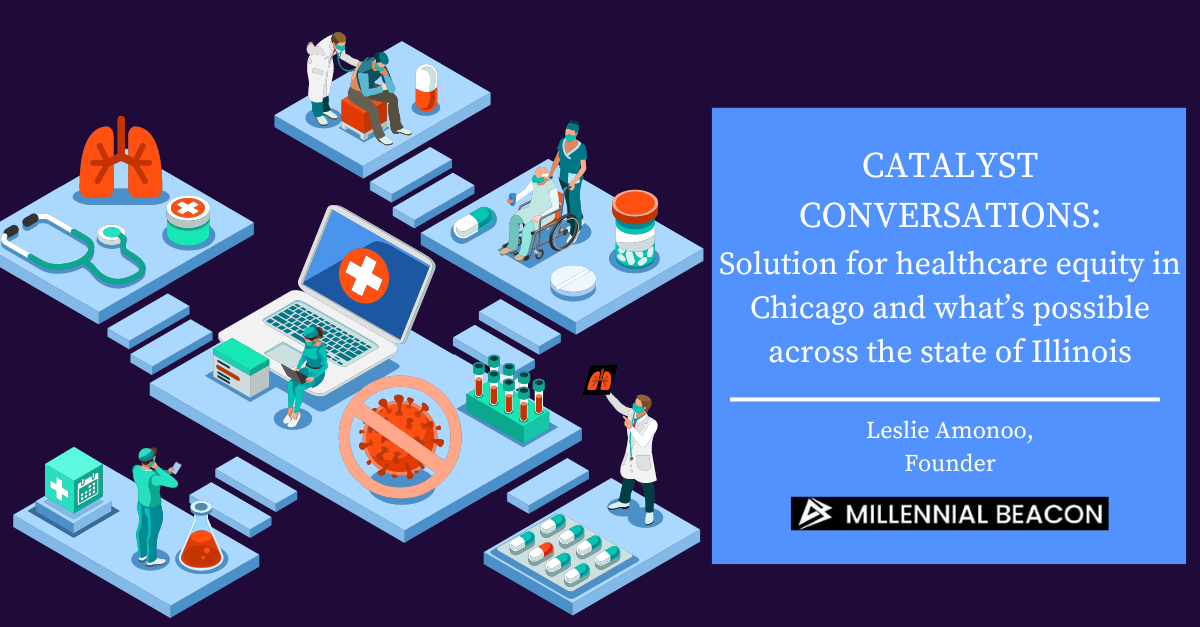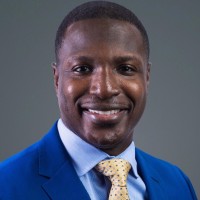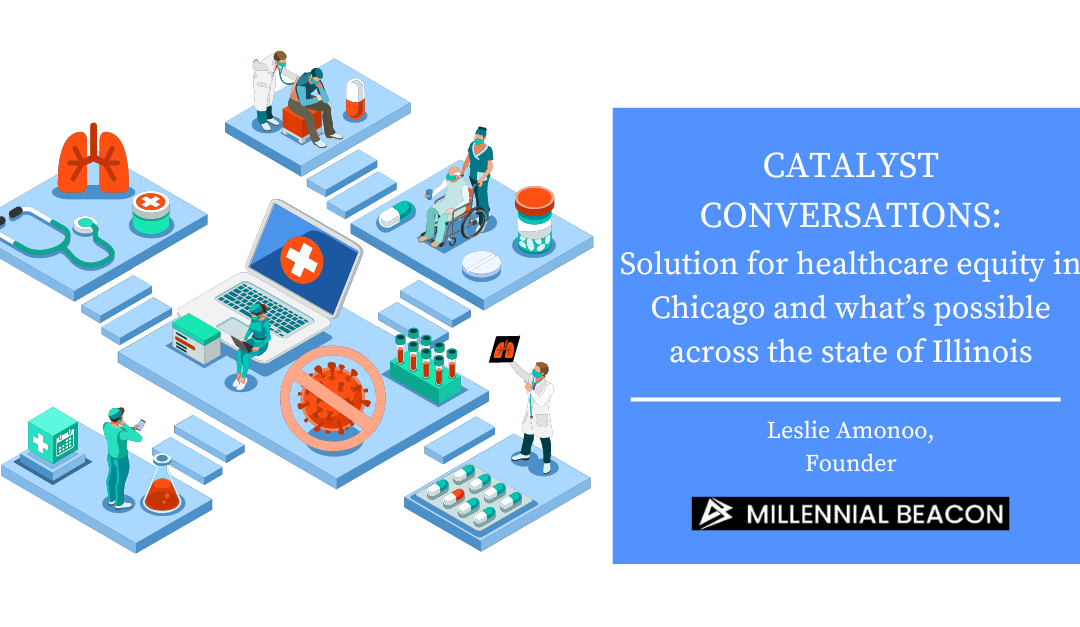
CATALYST CONVERSATIONS: SOLUTION FOR HEALTHCARE EQUITY IN CHICAGO AND WHAT’S POSSIBLE ACROSS THE STATE OF ILLINOIS
The pandemic has shone a bright light on persistent, systemic inequities in this country. Unequal access to economic opportunities, education, resources, and funding discrimination are just some of the systemic hurdles many communities face. Throughout Illinois, these affected groups include rural communities, elderly individuals, people at or near the poverty line, undocumented immigrants, people experiencing homelessness, LGBTQ individuals, people with disabilities, disconnected youth, and people with limited English proficiency.
The answer to resolving these gaps is the development, outreach and implementation of solutions that were designed to be culturally competent and tailored to specific populations to ensure that the hardest hit, underserved populations of Illinois are prioritized.
In this edition of Catalyst, we sat down with Leslie Amonoo, founder of Millenial Beacon. His organization is a healthcare incubator on the South Side of Chicago that develops solutions aimed at improving the factors that determine health in overlooked populations. The mission is to diversify the talent pool in healthcare innovation, creating a pipeline to innovative solution development and creating measurable positive impacts on the health outcomes of Black communities.

Leslie Amonoo, founder of Millennial Beacon
What was that light-bulb moment, in relation to your tie to Chicago, that started Millennial Beacon?
It really was born out of conversation with Dr. Vietta Johnson, Jason McGee, Ibie Hart, Jessica Johnson, and Jennifer Afranie – Sakayi. All those people have had the same kind of experience in terms of the South Side. They were all living in a community, where the medical care for people of color just looks a little bit different when it comes to how aggressive disease treatment can be. You look at the University of Chicago community needs assessment that documents causes of mortality like cardiovascular disease and diabetes. But these things aren’t just prevalent. They’re just much more aggressive to somebody who has the same kind of cases a couple of miles down the road on the north side or in the loop. So we came up with this solution basically out of this frustration that Chicago is home to world class research organizations and one of the biggest healthcare incubators in the country. Now we look at how we can take advantage of this ecosystem that we’re surrounded by to bring innovation to the people that need it the most.
The opportunities within STEM are so vast, but the representation of African American entrepreneurs, researchers, innovators within these spaces remains low. How do you plan to develop more equitable pipelines of talent for African Americans that may not be aware of these opportunities?
I think what happened is, over time, these STEM education programs were not funded well. We didn’t make it a priority in the community to make sure that there was sustainable private and public funding. We rely solely on public funding and that’s where the issues really began. Now you have people who are graduating who are looking to come back home and the opportunities they seek in these emerging industries were never developed on the South Side properly to facilitate their coming back. So now they’ve got to go to New York or L.A. to capitalize on opportunities because those infrastructures and as a result, those opportunities, already exist. But this isn’t too different from what we see in traditional venture capital. Traditional startups in the early nineties were going to New York and they were going to L.A. because the infrastructure was developed in those places. As we’re becoming more conscious of that, in terms of the ecosystem. We are working to build that programming infrastructure and secure stable funding sources in order to position Chicago as that third coast of innovation so we can keep all this talent in Illinois.
“ I think that one is changing the hearts and minds of folks to understand that the South Side is a viable place to invest in.”
What does building that pipeline infrastructure look like? How do you go about changing the landscape of opportunity?
The plan is changing the hearts and minds of folks to understand that the South Side is a viable place to invest. We need to convince investors to open up those venture capital dollars that we might not previously have had access to and making them more accessible in terms of building their infrastructure by investing in facilities and workforce development programming that will, in the end, create a bigger return on investment. All that talent that we see go to the Fortune 500 companies like Google and Apple – those young professionals want to come back home because at the end of the day, they want to be around their people, too. So if we can start to really coalesce what those tangible opportunities look like and invest in the south Side and build that infrastructure, I think that will start to reap the benefits of an ecosystem that’s truly representative of Chicago’s diversity. All of Chicago wins when we can do something like this and bring everybody to the table and address some of these inefficiencies and lack of resources that are right now present when you talk about startups and venture game.
What trends are you seeing in the number of black professionals getting into healthcare? Do you believe progress is being made?
We’re actually at an inflection point, right? What I mean by that is if you look at the trends in population flight in the last ten or 20 years in the Deep South Side, there has been tremendous population flight, almost to the tune of 20%. When you look at that and ask why, its because of the lack of jobs and lack of opportunity. That has implications for people’s health as well. If you look at the health care dollars that have been invested in that same time period, out of the $2 billion that has been invested in Chicago, 75% of that goes to the north side. 25% goes to the south side, where the University of Chicago is doing their best. But the key is not to leave it up to them alone.
We’re at a very critical juncture where there’s an opportunity to bring a lot of organizations, a lot of people, a lot of talent to the area that can change that trajectory. I think that some of the things that we’re doing, if you look back ten years from now, along with all of the all the stakeholders that are interested, can be the catalyst too change those numbers. And that’s what we’re really, really interested in doing.
Explain the importance of this new narrative around the South side and as this new hub of innovation.
There’s so much promise when it comes to the South side and the people in South Side. It’s just ripe for talent. There’s all these good things happening that we need to highlight in order to reclaim the narrative from what is being portrayed in the media. We’re not saying these negative things don’t exist. But we also recognize our people are moving in other ways that are super positive that we’re not shining enough light on that. I think that the opportunity for it to be a hub of innovation should overtake the negative generalizations that are often made about Chicago, in particular the South Side. And I think we a real opportunity to be able to do that.

